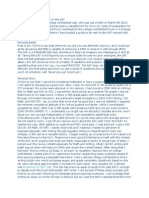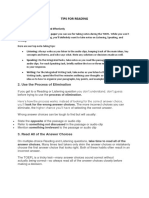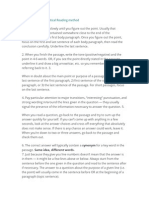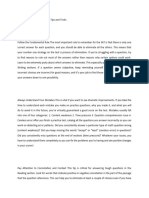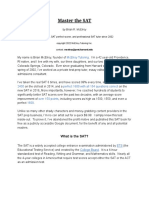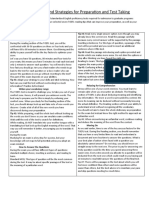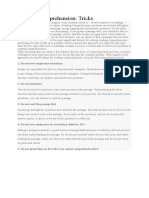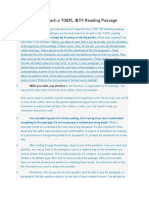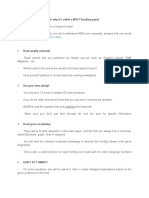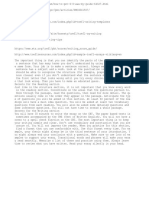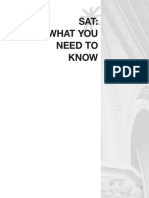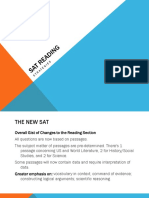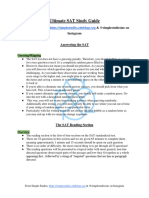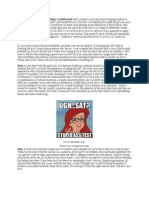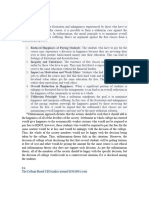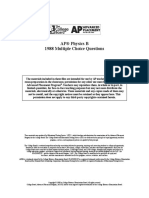This is Noitaraperp from College Confidential and I wanted to post my critical reading method in
more places so that more students could benefit from it. The SAT can definitely be a difficult process, and
I want to help all the high school students out there (and perhaps some instructors if they'd like to take
my suggestions). My critical reading approach has, since its publication on College Confidential (under
the thread title How to Attack the SAT Critical Reading Section Effectively), garnered roughly
125,000 views, and I hope to help more people down the line. This method which I developed essentially
lifted me from a 500 (initial diagnostic - I believe it was from the Blue Book) to an 800. So, here it is:
Do you want to learn the most infallible and least error-prone method of attacking the SAT Critical
Reading Section? Learn from someone who knows. I was accepted into Harvard with a 2400 (that sounds
pretentious, but you should know where I'm coming from so that you treat this advice as credible). I first
have to tell you that achieving a great score on SAT CR is not easy and there's no single silver bullet. As
with everything, this method requires repeated practice and experimentation before results can show.
Please read on as I share with you my successful method of tackling CR.
Step 1. Let's start with the approach. You have probably encountered people in your daily life who snidely
demean the SAT or at least the experience of taking the SAT. However, you must approach this important
experience with a fundamentally different mindset. Okay, perhaps the SAT is a test full of tricks - a test
purely to be gamed. If so however, learning to work within a system is a very valuable skill to have in life.
Furthermore, I believe that the fundamental basis of the SAT is not its tricks, but its call for a rapid
comprehension of certain situations, a supple maneuverability, and a positive approach to the material.
After all, a multiple-choice test with any semblance of difficulty can be said to contain tricks. How good is
your knowledge if you can't manipulate it to a small challenge? Don't demean your opponent - that's a
recipe for disaster. The last quality, a positive approach to the material, is the most important and the one
you can control the easiest. However, it does not come naturally (as can be seen with scores of grumbling
teens) and takes reinforcing.
Don't be like Hipster Ariel.
The SAT is not a stupid colonoscopy.
Step 2. A second word about approach: You didn't pay CollegeBoard 45 bucks so that you could be nice.
When you're faced with five choices on a question, you've got to be ruthless. Stop internally justifying why
one answer could be right, and instead make the shift to asking yourself why that answer could be wrong -
play Devil's Advocate, as cliched as that may sound. I can't tell you enough how much this shift in thinking
has helped me when I have been stuck between two seemingly correct choices. Despite appearances, all
choices ARE different and one is certainly the best, or else CollegeBoard would be losing thousands of
dollars to successful lawsuits. Keep this in mind. You have got to find the right answer and I will show you
how.
"CollegeBoard used basically the same answer twice! "
"No, we didn't, Timmy."
Step 3. It is my intention to focus mostly on the long reading passages in this How-To, since that is where
the majority of the CR questions lie and since these questions give many test-takers a higher level of grief.
For sentence completions, my biggest advice is to stop wasting your time on tricks, to buckle down, and to
start attacking vocabulary lists. Direct Hits is vouched for by many and proven to be most effective,
though I personally used Princeton Review's Word Smart I and II cover to cover (perhaps not as efficient
as the previously mentioned title). One problem is retention, so what I did was that I made flashcards for
every word I didn't know in the book (it came out to about 1000 words). It takes a long time, but it pays
off for the SAT, your reading, your writing, and your life. Only if you really know the words will you be
able to confidently answer sentence completions (and consummately schmooze at cocktail parties). For
the short passages, it's all about absorbing the small paragraphs as efficiently as you can before going on
to answer the questions. They're considerably easier if you keep your mind, and obsessing about the short
passages (going back to double or triple check) are a huge time drain. Most of the time, it's a quick fact
check paired with a tone question. If you practice a lot on long passages, short passages will be an easy
relief for you.
Step 4. Now, onto the long passages. I had loads of trouble with these before I found this method. I am
going to give you my step-by-step method of attacking them, which I have found extremely effective,
albeit somewhat more time-consuming. Before anything, you MUST read the short blurb before the
passage. It gives you a sense (though always limited) not only of what the passage is going to be about, but
also of the position and possible tone of the author. You will then be able to perhaps place yourself into
the author's shoes. This is a good point right now to tell you that you MUST love the passage you are
reading. Force yourself to love it - throw yourself into the passage with gusto. It works. Though it's quite
ludicrous to be super-enthusiastic about a boy and his alfafa patch, with your enthusiasm comes
retention, heightened focus, and an oddly vicarious interest in the passage. My general mental approach
was a huge contributing factor in my getting an 800 in CR and a 2400 on the SAT.
Step 5. After you have read that thrilling blurb, don't start reading the passage yet. Quickly jump to the
questions, and as fast as you can, skim every question for line number references (don't read the choices
or the full question yet). On some passages almost every single question has a line reference - on most
others it's about over half. Very rarely will you see a passage with question without any line references
(perhaps only rarely on a six question passage). Anyway, once you see a line reference (In lines 23-25 of
the passage, the author is saying that...), you should bracket not the lines, but the sentence contained
within the lines. This mark-up will allow you to focus in on that sentence once you begin to read the
passage. Based on the question, you want to make a small annotation. For this question: (In lines 23-25 of
the passage, the author is saying that...), you might make the annotation MEANING next to your marked-
up sentence. Other annotations might include: SAYS THIS BECAUSE, REFERS TO, HOW SIMILAR TO
PASSAGE 1, BACKS UP WHAT BEFORE (think crude caveman notations - they're more efficient). Go
through all of the questions. Perhaps some of the references will not have any line numbers. If you see (In
the last paragraph...), just put brackets around the last paragraph along with an annotation.
Annotate, efficiently.
If you see a general question referring to the passage as a whole, on the question circle the number of the
question with a large circle. This means it's a general question and must be answered AFTER all the
specific questions. I find this is always a very comfortable way of attacking the questions based on how
CollegeBoard writes these questions.
Step 6. Once you have marked up all the line references as fast as humanly possible, then the real art
begins. You must read the passage. There is no way around reading every single word. But HOW you read
it is the true art. Read the unmarked sections quickly yet efficiently, absorbing it briefly but not truly
pausing to analyze. ONCE you hit a marked section, slow down and absorb it. If you feel that it would not
disrupt your flow to answer the corresponding question, do so. If not, keep going a little more. A vast
majority of the line reference questions (even complex ones such as inferences) can be answered after
reading from the beginning to the point of reference. In a few instances, it may help to read past the point
of reference, but NEVER read the whole passage through without pausing to answer questions. Your
retention will be terrible and it's much better to handle the passage in small, manageable chunks. Also,
when you answer a question, just circle in the answer in the test booklet. DO NOT BUBBLE IN THE
ANSWERS UNTIL YOU FINISH THE ENTIRE PAGE, SOMETIMES EVEN THE PASSAGE. This is a huge
time saver and it prevents you from making bubbling mistakes. The time saved is not necessarily the time
difference in bubbling, but the time saved because it prevented you from breaking your focus. This is very
important in CR. Don't break focus. If you're very low on time however, you can bubble as you go.
Step 7. Once you have tackled all the line and paragraph references ruthlessly, you should have already
finished reading the entire passage and because you had focused in on the passage in numerous instances,
you should also be well-equipped to answer your circled general questions. I always find it's easier to
answer these general question at this point, seeing as how you hit up the passage numerous times already
along the way. Remember to never choose an answer unless you can truly back it up with evidence from
the passage. Even "inferences" do not stray far from the text. If they did, then the "best answer" would be
up in the air. Do not be misled by the word "inference" - it's a misnomer. A large number of these can
actually be pulled straight from the passage. It's all about the passage - not what you think or have learned
thus far in school. Being one with a text and not extracting too much from it is a valuable skill to learn.
Don't put words into the author's mouth. Another very helpful thing to remember when viewing the
choices is that extreme choices (including the words ALWAYS, NEVER, or BEST) are rarely ever correct
because they fall under the hard-to-prove category of generalization within inductive reasoning. Though
you've heard this tip many times and it sounds obvious, it is so helpful (yet easy to forget) and you often
find yourself internally justifying these kinds of generalizing answers. Just say no (in a ruthless yet
eternally positive way).
Step 8. My method of tackling long passages is somewhat time-consuming, but time is something that
can be reduced through assiduous practice. This method is so effective in getting the right answer, and I
fully vouch for it from personal expereince. What I also did during practice was that I gave myself twenty
minutes instead of twenty-five in the standard CR sections, and I rapidly tried to utilize my developed
method.
And here...we...go.
It was extremely difficult to meet the twenty-minute deadline at first but I got better and better at it
through practice. While time can be addressed easily through practice, a fundamentally bad approach to
the passages cannot. You should try out my CR method if you are having trouble with CR passages - be
open. This method I developed was THE contributing factor for my rise from a 500 (initial diagnostic) to
an 800 in CR. Thanks, and tell your friends about this article. Good luck!





